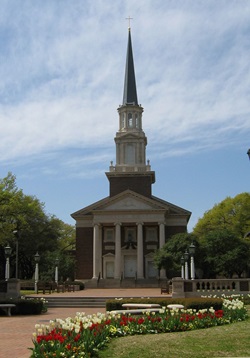 As the centerpiece of the Charles and Elizabeth Prothro Theology Quadrangle, Perkins Chapel serves as the primary worship setting for Perkins School of Theology and Southern Methodist University. Originally dedicated in 1951, Perkins Chapel was one of seven buildings constructed through the vision and generosity of Joe. J. and Lois Craddock Perkins of Wichita Falls, Texas. Today, Perkins Chapel stands as a sign of the spiritual life of the seminary and the diverse University community.
As the centerpiece of the Charles and Elizabeth Prothro Theology Quadrangle, Perkins Chapel serves as the primary worship setting for Perkins School of Theology and Southern Methodist University. Originally dedicated in 1951, Perkins Chapel was one of seven buildings constructed through the vision and generosity of Joe. J. and Lois Craddock Perkins of Wichita Falls, Texas. Today, Perkins Chapel stands as a sign of the spiritual life of the seminary and the diverse University community.
The Chapel plays a vital role in the spiritual formation and education of those preparing for leadership in the Christian church and offers sacred space for instruction in preaching and teaching. Its acoustics have made the setting an ideal forum as a sanctuary for private devotions, weddings, holy day celebrations, and recitals.
Perkins Chapel is a brick and stone version of a type of church built in New England in the 18th and 19th centuries, reflecting a Georgian style developed by Sir Christopher Wren. Its portico, supported by four Ionic columns, complements Bridwell Library and Kirby Hall, which also front the Charles and Elizabeth Prothro Theology Quadrangle. The Bridwell and Kirby cupolas with restored gold leaf anchor the quadrangle on the north and south, while the refurbished chapel steeple and cross dominate the west side.
Perkins Chapel, having served the campus and community for 48 years, was renovated in 1999 and again in 2019 after an unfortunate steam leak. The efforts were guided by the need to ensure the chapel's usefulness as a place of worship for a variety of religious and liturgical traditions, education for the seminary, and public service for the community, while maintaining its historical, architectural, and theological integrity.
Consistent with its Georgian attributes and modified basilican plan, the sanctuary is secured by a chancel of great stability in which all elements support the central action of liturgy—the sacred work of the people. The chancel extends into the nave, enabling the congregation to be participants in the worship experience rather than spectators. The wide space also allows for greater flexibility in the presentation of music, dance, and alternative liturgies, with front pews removable for larger performances and greater accessibility.
The chancel's altar, pulpit, and font, designed by liturgical artist Lyle Novinski, have their antecedent in English "Regency" furniture of the early 19th century, using cherry, with maple columns and Malaysian padouk details complementing the Georgian grammar of the chapel. The single, freestanding pulpit, unites the Word read and expounded. The pulpit's top is flat, uniting congregation and speaker rather than serving as a place where distinctions are made between keepers and hearers of the Word. The font's large spun basin is hand-fashioned in bronze.
In deference to the Roman influence on Georgian design, the altar rail—removable to accommodate various liturgies and religious traditions—was inspired by a Roman sarcophagus. Using an s-curve design, the rails are fashioned in bronze with balusters. Bronze candlesticks, rising in height to the altar top, complement the rail, while mimicking a Roman lampstand design. The central Christian symbol of the cross, crafted of beveled molding and covered in gold leaf, completes the chancel and serves as the visual genesis for the architectural trim throughout the sanctuary.
Gilded Corinthian capitals and dentil work highlight once-hidden architectural details and emphasize changes in plane and light throughout the room. A lighting system further emphasizes the coloration and volume of the chapel space.
A wood floor enhances Perkins Chapel's exceptional acoustics for instrumental and choral arrangements. The multimedia and audio system enables multiple configurations of musicians, leaders, and virtual participants. A Steinway grand piano is a gift of SMU trustee Dr. Bobby B. Lyle ('67) of Dallas, in honor of the Rev. Katherine Glaze Lyle ('71,'73,'94).
Since 1997, the chapel's balcony has housed the renovated 12-rank mechanical action organ originally built for SMU's Meadows School of the Arts in 1969 by Dallas organ builder Robert Sipe.